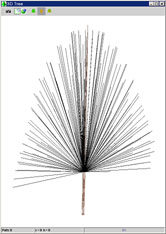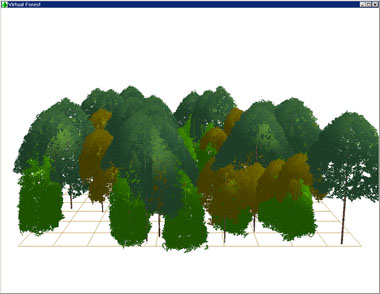|
|
The STReTCH
Model A
generic crown development model for multi-species forest stand modelling
Main assumptionsTrees respond to crowding in a variety of ways. The STReTCH model captures three major types of responses affecting crown shape Spatial competitive exclusion
Shade avoidance and growth reorientation towards the direction of maximum incident light
Alteration of h-dbhrelation and crown depth as a result of local crowding
Fig.3: Alteration of allometric relations in Lansium domesticum (a tropical fruit tree) grown in a dense stand. Trees respond to crowding by favouring growth in height to the expense of secondary growth (fig 3a) and by shedding; their lower most branches (fig 3b). Remarkably the relation between crown width and trunk diameter remains largely unaffected (fig 3c) Model ImplementationA tree crown is represented as a deformable solid. Crown deformation can be global in response to increased vertical light gradient or local in response to radial anisotropy of incident light or spatial constraint. Local deformation is mediated via a set of vectors stemming from crown base and subtending the crown envelop (fig 4a & 4b show tree high-lighted in fig.5). Extension of the subtending vectors is affected by local light and space availability as determined by species specific parameters.
The STReTCH model is coupled to a spatially explicit individual based forest stand simulator (http://www.worldagroforestrycentre.org/sea/Products/AFModels/SExI). The simulator computes incident light received by each tree for a series of azimuths and inclinations.
Fig. 5: Planar view of a 30 year old simulated stand of 60 randomly scattered trees belonging to three species growing on a 50x50 m plot. Note marked crown deformation in locally packed areas
Fig. 6: Hemispherical mapping of the light received by the high-lighted tree in fig.5
Fig. 7: 3D view of stand shown in figure 5 Note crown depth alteration, and asymmetric crown development depending on local conditions (Fig. 7a wire frame view, Fig7b with texture rendering)
°IRD - ENGREF, 648 rue Jean-François Breton, Domaine de Lavalette - PB 44494, 34093 Montpellier Cedex 5 |
||||||
|
Update 10-06-2005 Comments and questions send to: |
© Copyright ICRAF 2002 -
2005 http://www.worldagroforestrycentre.org/sea |
 Fig. 1: Canopy of
Shorea javanica agroforest
showing typical crown shyness : crowns
grow clearly separated from one another, with intervening vegetation-free
borders (Krui, Sumatra)
Fig. 1: Canopy of
Shorea javanica agroforest
showing typical crown shyness : crowns
grow clearly separated from one another, with intervening vegetation-free
borders (Krui, Sumatra)
 Fig. 2: Spectacular shade avoidance response
of Pinus pinea tree, a light demanding species, grown close to hedge of
poplar (coppiced stems still visible on the right). Response combines
reorientation and selective abortion of secondary axes (Montpellier,
France).
Fig. 2: Spectacular shade avoidance response
of Pinus pinea tree, a light demanding species, grown close to hedge of
poplar (coppiced stems still visible on the right). Response combines
reorientation and selective abortion of secondary axes (Montpellier,
France).








